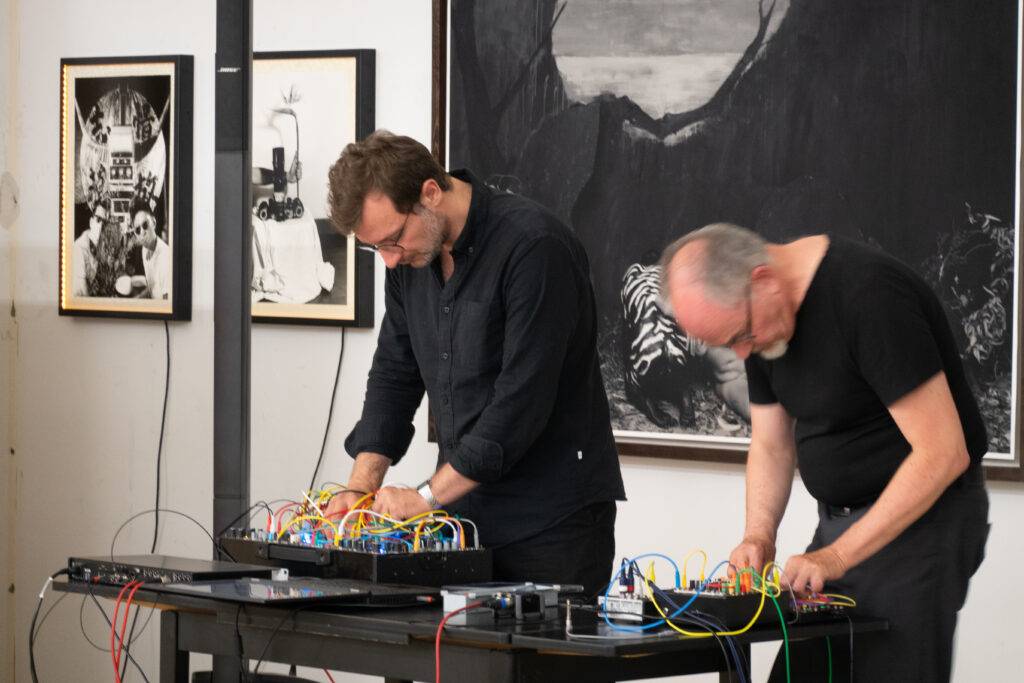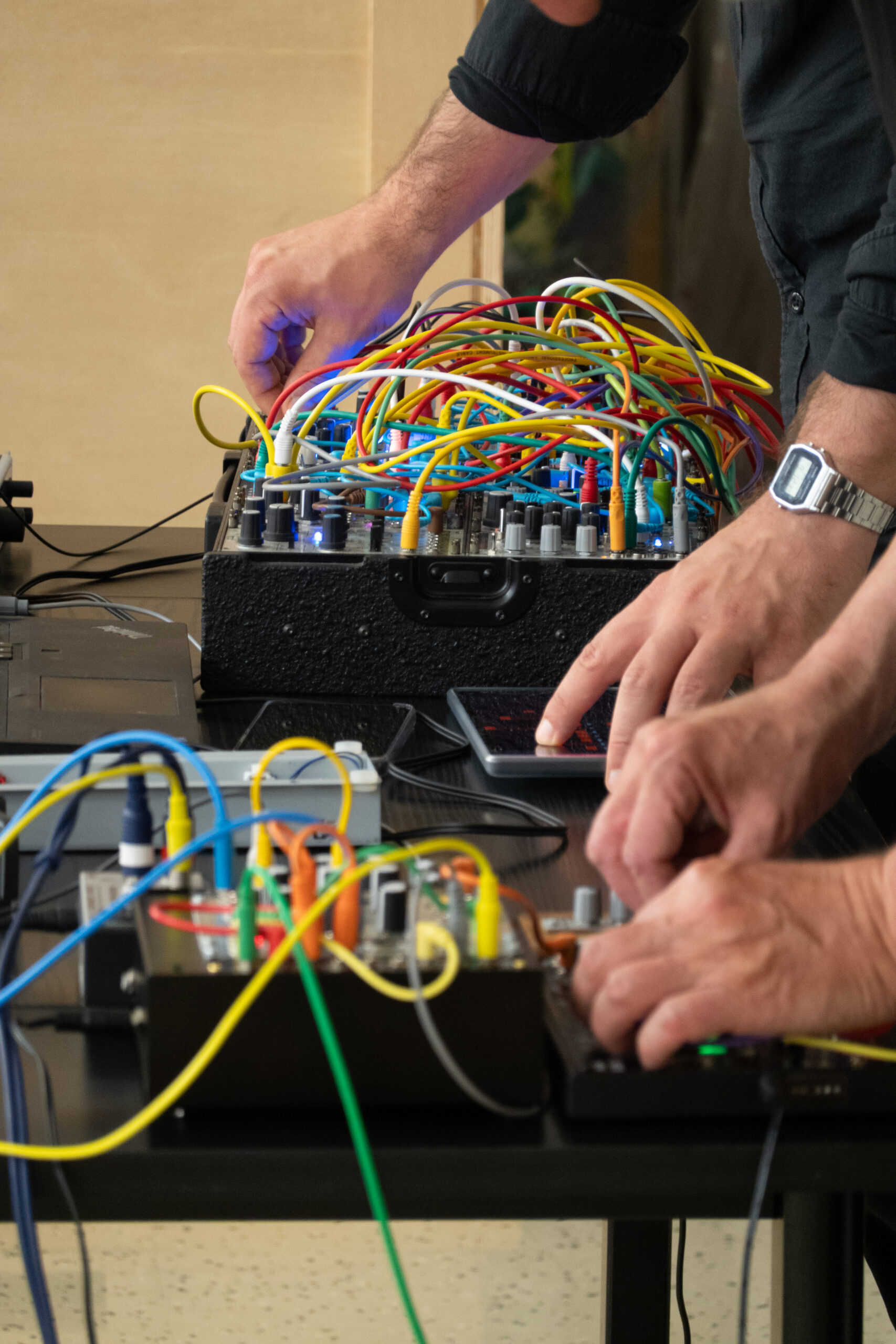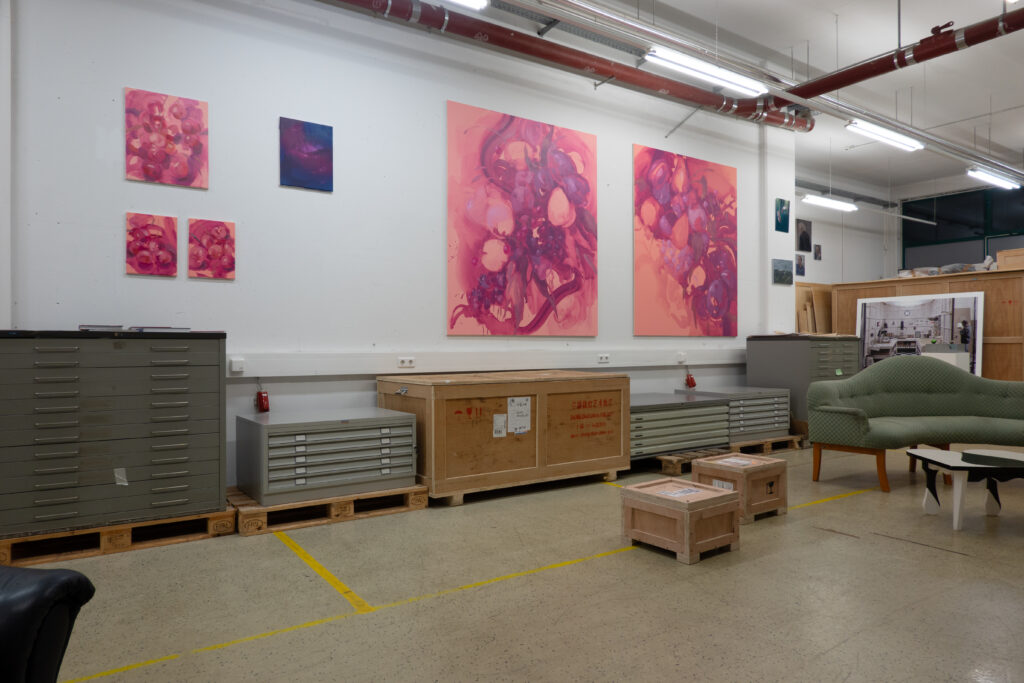Electronic Sound Waves at the BMCA Storage
CLIENT: BMCA Storage
WORK: Writing an article about the performance "One on One", performed in Vienna by Karlheinz Essl and Luc Döbereiner
Electronic sound waves at the BMCA Storage
The two composers Karlheinz Essl and Luc Döbereiner performed in the BMCA Storage for their “One on One” performance. With their self-configured analogue synthesiser modules, they took the visitors on an improvised, non-linear sound experience. On that evening, the Storage with the exhibited art became a laboratory of experimental sound that entered a symbiosis with the space, the viewers, and the artworks. This was also the case with Bianca Regl's exhibited work series "Snyders Cherries" as part of the new format #occupyBMCA, where Regl, as the first invited artist, displays her works on a designated wall of BMCA Storage. The paintings interwove with the sound of Essl and Döbereiner and offered a new view of the series. An artist talk with Bianca Regl will follow this summer of 2024.

Preparations began, the buffet was set up and the two composers did a quick sound check.
As well as being a composer, Karlheinz Essl is also a performer, software developer and media artist. He is a Professor of Composition and Electroacoustics at the Vienna University of Music and Performing Arts since 2007.
Essl's compositional thinking is characterised by computers and the poetics of serial music. He has also developed software for algorithmic composition and live electronics.
Luc Döbereiner is a Professor of AI in Composition and Sound Synthesis at the Trossingen University of Music. He is interested in composition models, algorithms, non-standardised sound synthesis, improvisation, materiality, AI and complex systems in musical composition and sound art.
The “One on One” performance is the result of a recent collaboration between Essl and Döbereiner. BMCA warmly opened its doors to the two artists.
“Music first”, says Döbereiner after Essl asks if they should give a short introduction before the performance. With no explanation at the beginning, the listeners are thrown back on themselves, allowing the sound performance to manifest and develop in the room. Then suddenly the electrical vibrations start to sound. As a listener, one is completely exposed to the sound experience and absorbed by it. For untrained ears, it is unfamiliar at first. The ear is searching for a rhythm, a melody. The sounds are loud, then tinnitus-high or fall into deep depths, sounding muffled, fragile like underwater. The vibrations change from calm to chaos – or are both at the same time. From the moment one stops looking for patterns, the performance can unfold thoughts like in a stream of consciousness and trigger different associations among the participants, making them part of the performance.


The abstract confusion begins to materialise, to make “sense”. Some visitors have closed their eyes, are introverted or scan the room with their eyes, letting their gaze linger on a work. The listeners are attentive, the tension palpable. It is a little reminiscent of jazz, improvised, unpredictable, sometimes with a joke or commentary on what has just been played. But also of the US composer John Cage. An important co-founder of the Fluxus movement from the 1960s. His works are strongly characterised by aleatorics and the production of unintentional sounds.
This is also the case with the two sound artists: “For a long time, I only worked on digital media. But what I like about analogue is that it's less predictable and surprises me.”, says Essl during the break, as he explains me the synthesiser modules with their many coloured cables, which are appearing playfully connected. In terms of aesthetics, these modules are works of art in themselves.
After the break with drinks and appetizers, the performance continues. The gaze continues to wander through the room and its displayed artworks. Constantly re-contextualising what is seen with the change of sound. This also applies to Zong Ning's works, which were hung directly behind the performers. The large-format black and white photographs "Rouge Tigres” and “Mountain Spirit” from 2016 were suddenly transformed into a sci-fi dystopian setting, the naked woman into a mystical being.
Bianca Regl's large paintings could be perceived across the senses through the performance. Although the warm pink-purple works in the “Snyders Cherries” series reveal berries, fruit and organic elements, they are painted openly enough with a coarse, soft brush that they can be metaphorised along with the sound.

The evening with the “One on One” performance at BMCA Storage allowed the visitors to immerse themselves in a soundscape-like new hidden world that seems unclear and chaotic at first glance. From the moment one thought to understand the melody, it got lost in the stream of electronic music waves. Everything was subject to constant change. To quote the German composer Karlheinz Stockhausen, one of the most important and brilliant composers of electronic music in the 20th century: “Music should not only be a wave bath for body massage, a sounding psychogram, a thought programme in tones, but above all a stream of superconscious cosmic electricity turned into sound“.
Text: Neve Regli
Photos: Rita Chen